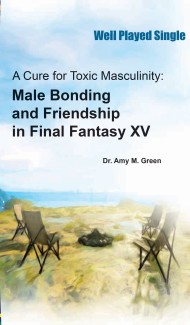A Cure for Toxic Masculinity

This book analyzes the video game Final Fantasy XV’s positive depiction of the importance of homosocial bonds in men’s lives, and why this depiction has become a profoundly important example of the importance of digital storytelling.
The bonds of friendship among Final Fantasy XV’s four male protagonists serve as a consistent sanctuary against the events with which they must contend. Even once the events befalling them become bleaker, the four still find moments of levity and hope, reminding the player of the hopeful nature of their youth, even once the narrative skips forward ten years and Noctis returns prepared to die to save Eos.
The particular story told in Final Fantasy XV, that of the bonds of brotherhood between four young men thrown out into the world and forced to survive the loss of one of their own, comes at a critical juncture in Western culture. Men of all ages deserve better than the persistent images of masculinity found in much of our storytelling that equate emotional vulnerability within a same-sex male friendship as emasculating and weak. Ignis, Prompto, Gladio, and Noctis serve as proof that friendship does not have to be portrayed this way. A continuing no-win situation persists for many men today, young and old, in terms of their ability to express deep bonds with one another. They are frequently trapped by society’s limited sliver of acceptance by which men are allowed to show emotional depth. Too frequently, the image perpetuated through our popular media culture is one in which male friendships are mocked, predicated on aggression and competition, or only possible if one or both parties are inebriated.
Through Final Fantasy XV’s bold depiction of male friendship and the emotional vulnerability that can exist therein, a diverse body of gamers experiences a positive depiction of the importance of homosocial bonds in men’s lives through the immersive and participatory storytelling inherent to the video game format.
